-

Visiting Rome? You Won’t Want to Miss These Attractions!
It is often quoted, “When in Rome, do what the Roman’s do.” As the capital of Italy, it is the world’s 14th most visited city. Despite being only 500 miles, it has almost four and a half million residents. It is outlined by the Tiber River with a history that spans 2500 years (although remains of bodies have been found going back 10000 years). With the Renaissance came an explosion of architecture, art, cathedrals, massive public spaces and more.
Today, Rome is still a thriving metropolis, offering travelers both a glimpse of the ancient world as well as the most up to date modern amenities in the market place. There’s so much to do you could practically fill up the Colosseum with your to-do list. For now, may we offer these choices?
JoyTravel Presents Rome!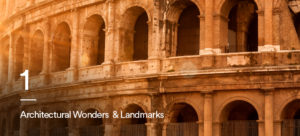
1.Architectural Wonders and Landmarks
Palatine Hill: Sitting 40 meters above the Roman Forum and looking down on Circus Maximus, the Palatine Hill sits in the middle of the Seven Hills of Rome. It’s in the oldest part of the city. The center most of the Seven Hills of Rome and is one of the most ancient parts of the city.
Circus Maximus: Forget Barnum and Bailey or Ringling Bros., this now famous park Latin’s name means “Great Circus” – and it was! At a bit over 2000 square feet in length, 150,000 people used to attend chariot races, horse racing and various other public games. It was also a venue for celebration when for Roman war victories.
Appian Way: Anything made famous in Italy likely traveled down the Appian way. This was the most significant road in the old republic, connecting Rome to its sister town, Brindisi.
Ara Pacis: This famous altar was built to honor the Roman goddess of peace, Pax. It was built in 13 BC and is still considered to be an amazing piece of sculpture.
Colosseum: This amphitheater was at the heart of Rome. Constructed of sand and concrete, it is still considered to be the largest one of its kind in the world. Up to 80000 people would pack the stands to watch gladiators fight to the death. Lions, tigers and other animals would be set loose on victims, all to the cheers of the crowd.
Pantheon: The Pantheon was a temple built in 126AD and is famous for its beautiful vertical arches, dome and statues. It is one of the most photographed sites in the world and admired for its sturdy frame and beautiful stonework.
Roman Forum: Anything political in Rome happened right here in the Forum. Much of its remains today show hints of what Roman life was like dating all the way back to 753BC.Bonus Visits:
As if the above list wasn’t enough, may we suggest you consider:
The Pyramid of Cestius
Arch of Constantine
Pizza Novona
Spanish Steps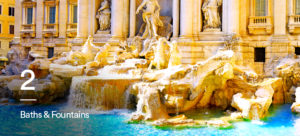
2.Baths & Fountains
The baths of Rome were not only an architectural wonder with their pipes and beautiful stone work, but they were essential to Roman hygiene as well as its social life. People gathered round the baths for gossip, cleanliness and for some good old fashioned exercise. Here are a few to check out!
Baths of Caracalla: These were built around 213 AD and admired for their size as well as their various water temperatures. One could take a cold, medium or hot bath (thanks to a roaring furnace).
The Baths of Diocletian: These were built at the end of the third century. They were considered some of the most elaborate baths in Rome. The stone work and empty pools are still a source of delight and wonder to tourists hoping to catch a glimpse of yesteryear.
Fontana dei Quattro Fiumi: Standing for the Fountain of the Four Rivers, this beautiful landmark is located in the Piazza Novona. It is relatively modern (for Rome Standards!) as it was not built until 1651. It’s beautiful stone carvings represent the 4 major waterways of Asia, Africa, Americas and Europe.
Trevi Fountain: Designed by Pietro Bracci and Nicola Salvi, this fountain is famous for its legend. The story goes that back in 19BC, parched Roman soldiers followed a virgin to a natural spring of pure water which caused Augustus to build a fountain in its honor. It became a leading aqueduct for the city and is now known for the coins that people toss into it for luck and love.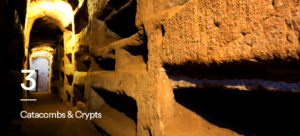
3.Catacombs & Crypts
Catacomb of Callixtus: Those who don’t mind creepy and dark tunnels will enjoy the Catacomb of Callixtus. Located on Appian way, it is famous for housing many popes.
Capuchin Crypt: This crypt is located underneath the church of Santa Maria della Concezione dei Cappuccini and holds the skulls and bones of almost 4000 friars. Those who cringe easily will want to skip this dark and, well, cryptic crypt. It’s one of the spookier haunts in Rome.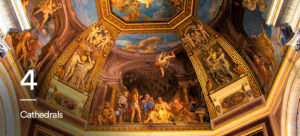
4.Cathedrals
Basilica of Saint Paul Outside the Walls
St. Peter’s Basilica: Fans of the Renaissance won’t want to miss this piece of architecture. It’s open and airy and adequately displays what life used to look like in the Vatican City.
Sistine Chapel: Is there any place more beautiful than the Sistine Chapel? You’d be hard pressed to find one. Made famous by Michelangelo, this was restored in 1477 and considered one of the most aesthetic houses of worship in Italy.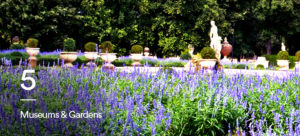
5.Museums & Gardens
Museums and gardens run rampant through Rome. Here are just a few to consider:
National Etruscan Museum
Doria Pamphili Gallery
Galleria Borghese
Vatican Museums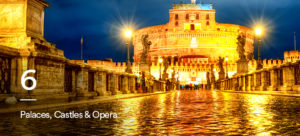
6.Palaces, Castles & Opera Houses
A trip to Italy would not be complete without a tour of some opulent palaces and castles. A few to consider include:
Quirinal Palace
Castel Sant’Angelo
Teatro dell’Opera di Roma
7.Food
There are a ton of restaurants and bars to frequent in Rome, but if you had to choose just one place to stop, this would be our recommendation:
Campo dei Fiori: This outdoor market is a perfect slice of local life. From its fruit and meats to nuts, poultry and spices, this is the oldest farmer’s market in Rome (it began in 1869) and is an excellent way to practice your Italian while eating some of the best fresh food in the country.Joytravel Knows Rome
If one word were to describe Rome, that word would be “Joy.” Here at Joytravel, we would love nothing more than to help you plan your trip of a lifetime to Rome. Ciao for now!













